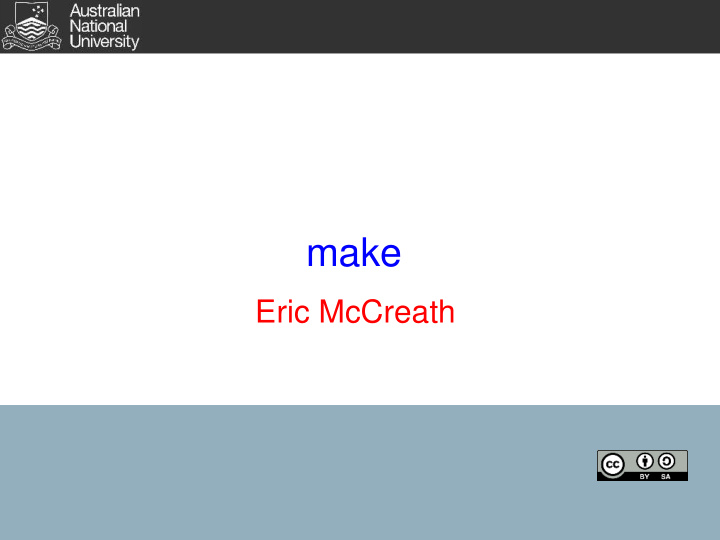



make Eric McCreath
Overview In this lecture we will: introduce the idea of automatic build systems overview the make command and how it works learn about the basics of the format of a Makefile look at some Makefiles for Java projects, and examine some more advanced options 2
Build Management Tools As programs grow larger, compliing them often becomes more complicated. As a programmer, attempt to avoid: typing the commands each time (which is time consuming and you may miss compiling changed source), have a script that compiles everything (for big programs this can make compiling a very slow process). If libraries or compiler options are used when compiling code, it is good practice to record these for future reference. For small, single file programs a simple way of documenting how to compile the code is to include the compile command as a comment in the source. However, for larger codes a build management tool must be used. 3
Build Management Tools The make command is old, simple and widely used. However, other popular tools include: ant - used widely for Java. Uses XML files for describing requirements eclipse - has inbuilt tools for compiling code maven - is targeted at Java and uses XML although it has more default behavior based on available files configure - used for generating Makefiles for different systems jenkins - a continuous integration tool run on a server. Usually configured to do nightly compiles/builds and perform various tests. 4
make The make command, when executed, looks for the Makefile (or makefile ) in the current directory. This file describes: the commands used to compile the code what source files need compiling the dependencies between the source files. 5
make make uses the dependency information in the Makefile along with the modification times on those files to determine which commands to execute. The disadvantage of this approach is that a small change in one file can trigger an avalanche of dependencies which may require the entire code base to be re-compiled. The make command is targeted at compiling code. However, it can be used in other situations when commands need to be executed based on modification of files. For e.g. the latex document system, or static html generated from scripts 6
Makefile The Makefile is just a plain text file that is formatted in a very particular way. it is made up of a sequence of rules each rule has a target (or targets) rules have a list of dependencies (which are either files or other targets) rules are followed by a sequence of commands that would normally, based on the dependencies, generate (or achieve) the target anything on a line after a # is just a comment. 7
Makefile # rule 1 target1 : dep1 dep2 dep3 command1 command2 # rule 2 target2 : dep4 dep5 command3 IMPORTANT - the Makefile format requires a tab before the command Also notice the ":" after the targets. 8
Simple Example If the text below was saved in a Makefile within a directory containing "Hello.java", the make command could be used to build, run and clean up the code. Hello.class : Hello.java javac Hello.java run : Hello.class java Hello clean : rm Hello.class If make is run with no parameters then the target of the first rule is the target that will be executed make can also be executed with a target as a parameter. For e.g. in this case make run or make clean 9
Macros Often some text within a Makefile is repeated. One might want to have a variable which is modified at one point in the Makefile and re-used in multiple places within the file. Macros can be used for this purpose. To define a macro: MACRONAME = macrostring It is used as $(MACRONAME). An example Makefile is: OPTIONS = -cp bin:. -g Hello.class : Hello.java javac $(OPTIONS) Hello.java Macro instantiation is lazy. They are only expanded when used. There are a number of useful predefined macros including: $? - the dependencies of the rule being executed $< - the first dependency $@ - the target being executed 10
Patterns Often the same set of commands need to be executed on the same type of files. Rather than specify the actual filenames, a pattern representing the filenames can be specified. The rule below would compile C code (files with suffixes .c) into their respective object binaries (files with suffixes .o) %.o : %.c gcc -c $< -o $@ 11
Exam Questions - Examples What are some reasons for using build management tools ? Explain how the make command determines which commands to execute. Suppose you had a project that consisted of the following Java source files: MainGUI.java, WorldState.java, and OtherInfo.java. With the MainGUI.java containing the main method, construct a simple Makefile that would enable you to compile (using just "make") and run (using just "make run") this project. 12
References Wikipedia has a few useful pages on this topic: http://en.wikipedia.org/wiki/Make_%28software%29#Modern_versions http://en.wikipedia.org/wiki/Build_automation The GNU make manual: http://www.gnu.org/software/make/manual/make.html Or just man make: % man make 13
Recommend
More recommend